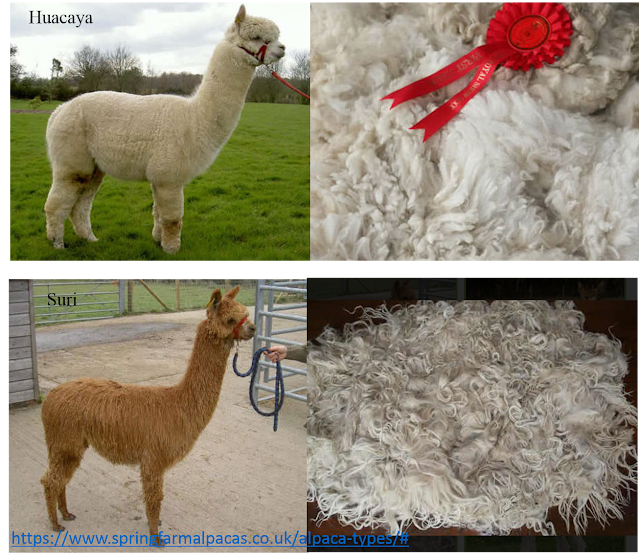Alpaca
Alpacas and llamas are members of the camelid family. Llamas and alpacas are not wild but domesticated. The alpacas is greatly appreciated for its many qualities, not least of which is the value of alpaca wool, known as fiber. It is soft, strong, and warm (warmer than most sheep wool).
Types of alpaca
- A huacaya alpaca
- A suri alpaca
The huacaya appearance is due to its fibre growing vertically out of its skin in small bundle with a tight crimped wave which makes the fleece sit vertically off the skin giving it a Teddy Bear look.
The suri appearance is due to its fibre growing out of the skin in bundles/locks without any crimped wave. This makes the suri locks twist and hang down along the flank of the alpaca giving it an appearance like a Wensleydale sheep.
Behavior
Alpacas and llamas are social animals and flock oriented. They produced muted but distinctive humming sound to communicate with one another. Humming is heard frequently with a dam and her cria. They produce a clicking sound as a warning to alert others to potential danger, and grumble at one another if personal space invaded. Alpacas and llamas can also produce high-pitched screams if they are extremely frightened or during breeding.
Offense and defense weapons used by camelids including kicking, charging, chest butting, biting, and spitting onto other camelids or people. Alpacas and llamas demonstrate annoyance by spitting or regurgitation. This starts as gurgle, or split, can reach as far as six feet and is very accurate in striking a target. The fluid has a strong, abnoxious odor that cannot be easily removed especially from clothing.
Ear and tail positions are good indicators of how an alpaca or a llama is likely to behave. Attitudes can be evaluated by ear and tail position.
Diet
- Alpacas only eat vegetation (herbivores). They eat mostly grass. The diet of alpacas consists of hay, leaves, and pellets.
Vital Signs
- Temperature: 37.5-38.9 C
- Respiratory rate: 10-30 breaths per minute
- Heart rate: 60-90 bpm
- gut contraction : 3-4/minute
Alpaca weight and reproduction
- birth: 9-14 kg
- mature: 110-250 kg
- Males reach sexual maturity at the age of 3 years while females are ready to mate earlier at the age of 1 year.
- Gestation period: 242-345 days.
- Babies feed upon maternal milk for 6 months and are weaned earlier or later, depending on growth rate.
Vaccination
Administration of vaccination is not difficult with correct restrain. The vaccine is given subcutaneously in the axillary area or just behind the elbow. There is a little area of looser skin that can be tented to place the needle under the skin. Use of axillary area helps reduce the possibility of adverse vaccine reaction and causes less pain for animal.
Vaccination commanly used in Camelids (CD/T)
- Clostridium perfringens type C,D, and C. tetani
- C. perfringens has been implicated in diarrhea and sudden death in crias and occasionally adults. All animals are at risk for tetanus following infection primarily through wounds, castrations, etc.
- Vaccination schedule: Adults yearly; pregnant females 4-6 weeks prior to parturition; crias at 3-4 months old and again 4 weeks later then yearly thereafter.
- Vaccine: Covexin 8
All clostridial vaccines are made from the modified toxins of
the given bacteria, so it stands to reason that giving more of these toxins increases the risk of
adverse reactions to a vaccination in the form of allergic/anaphylactic reactions, fever and/or
illness, and possibly abortion in pregnant animals.
CD/T vaccine should be given subcutaneously, 2cc per animal. Animals over one year of age
can all be vaccinated annually as a group without regard to pregnancy status, etc. New animals
with unknown vaccination histories should get two doses three weeks apart, then annually with
the rest of the herd.
Refererances:
Judah, V and Nuttall, K., 2017. Exotic animal care & management, 2nd eds. Cengage Learning.
Springfarm alpacas https://www.springfarmalpacas.co.uk/alpaca-types/#
Westwind Alpacas www.alpacas.ie
Jenkins, H., 2016. http://www.healingspringsanimalhospital.com/Images/ALPACA-GENERAL-MEDICINE-LECTURE.pdf
Washinton State University, 2006. https://vth.vetmed.wsu.edu/docs/librariesprovider19/Camelids/vaccinationscamelids.pdf?sfvrsn=35921c38_0
Wellington Veternary Clinic, Inc. https://www.wellingtonvet.com/forms/al_vaccination_&vitamins.pdf






Komentar
Posting Komentar